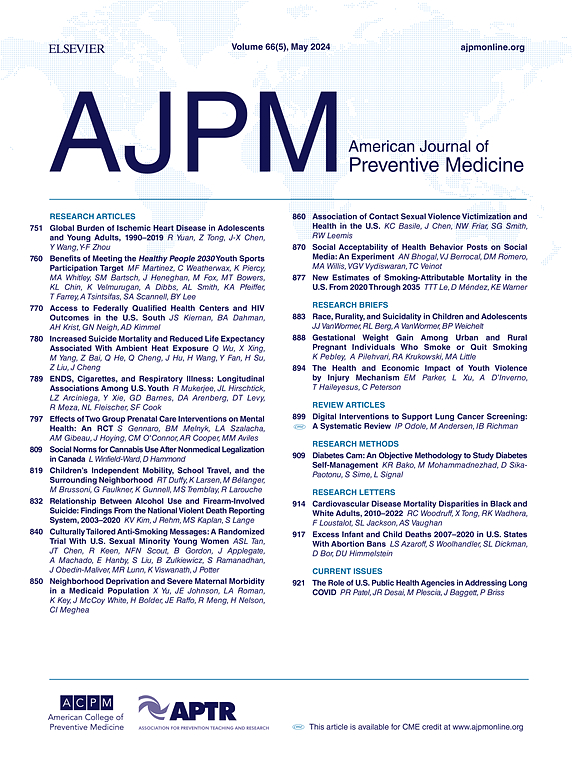Early Supplemental Nutrition Assistance Program Emergency Allotment Withdrawal and Household Food Insufficiency
IF 4.3
2区 医学
Q1 MEDICINE, GENERAL & INTERNAL
引用次数: 0
Abstract
Introduction
To mitigate increases in food insecurity during the COVID-19 pandemic, the U.S. Department of Agriculture allowed states to distribute emergency allotments to households participating in the Supplemental Nutrition Assistance Program, which substantially increased benefit amounts. Emergency allotments were available through March 2023, but 18 states chose to withdraw from emergency allotments early. The purpose of this study is to estimate the effect of early emergency allotment withdrawal among Supplemental Nutrition Assistance Program–eligible households.
Methods
Data were obtained from the Household Pulse Survey from January 2021 to February 2023. Analyses were restricted to 290,752 households that were estimated to be Supplemental Nutrition Assistance Program eligible on the basis of state-specific eligibility criteria. Staggered difference-in-differences models estimated effects of Supplemental Nutrition Assistance Program emergency allotments withdrawal on food insufficiency overall and by household income because relatively higher-income households experienced greater reductions in benefits. Analyses were conducted in 2024.
Results
Twenty-three percent of households reported experiencing food insufficiency before early emergency allotments withdrawal. Emergency allotments withdrawal was associated with a 3.6 (95% CI=1.0, 6.3) percentage-point increase in household food insufficiency, a relative increase of 16%. Food insufficiency increased more for higher-income households (change=7.9 percentage points, 95% CI=2.0, 13.8) than for the lowest-income households (change=2.2 percentage points, 95% CI= −0.9, 5.5).
Conclusions
Early withdrawal of Supplemental Nutrition Assistance Program emergency allotments was associated with increased household food insufficiency, especially for households that experienced the greatest reduction in benefits. Higher Supplemental Nutrition Assistance Program benefit amounts may be warranted given the large number of households that continue to experience food insufficiency in the aftermath of the COVID-19 pandemic.
早期SNAP紧急拨款撤回和家庭粮食不足。
导览:为缓解2019冠状病毒病大流行期间粮食不安全状况的加剧,美国农业部允许各州向参加补充营养援助计划(SNAP)的家庭发放紧急拨款,这大大增加了福利金额。EA一直持续到2023年3月,但有18个州选择提前退出EA。本研究的目的是估计早期EA退出对snap符合条件的家庭的影响。方法:数据来自2021年1月至2023年2月的住户脉搏调查。分析仅限于生活在提前撤回EA的18个州之一的290,752个家庭,并且根据州特定的资格标准估计这些家庭符合snap资格。交错差中差模型估计了SNAP EA退出对总体粮食不足和家庭收入的影响,因为相对高收入家庭的福利减少幅度更大。分析于2024年进行。结果:23%的家庭报告在早期EA戒断前出现食物不足。停用EA与家庭食物不足增加3.6个百分点(95% CI: 1.0-6.3)相关,相对增加16%。高收入家庭(变化=7.9个百分点,95%可信区间:2.0-13.8)的粮食不足程度高于最低收入家庭(变化=2.2个百分点,95%可信区间:-0.9-5.5)。结论:SNAP EA的早期停药与家庭食物不足的增加有关,特别是对于福利减少最大的家庭。鉴于在2019冠状病毒病大流行之后仍有大量家庭面临粮食短缺,提高紧急援助计划的补贴数额可能是有道理的。
本文章由计算机程序翻译,如有差异,请以英文原文为准。
求助全文
约1分钟内获得全文
求助全文
来源期刊

American Journal of Preventive Medicine
医学-公共卫生、环境卫生与职业卫生
CiteScore
8.60
自引率
1.80%
发文量
395
审稿时长
32 days
期刊介绍:
The American Journal of Preventive Medicine is the official journal of the American College of Preventive Medicine and the Association for Prevention Teaching and Research. It publishes articles in the areas of prevention research, teaching, practice and policy. Original research is published on interventions aimed at the prevention of chronic and acute disease and the promotion of individual and community health.
Of particular emphasis are papers that address the primary and secondary prevention of important clinical, behavioral and public health issues such as injury and violence, infectious disease, women''s health, smoking, sedentary behaviors and physical activity, nutrition, diabetes, obesity, and substance use disorders. Papers also address educational initiatives aimed at improving the ability of health professionals to provide effective clinical prevention and public health services. Papers on health services research pertinent to prevention and public health are also published. The journal also publishes official policy statements from the two co-sponsoring organizations, review articles, media reviews, and editorials. Finally, the journal periodically publishes supplements and special theme issues devoted to areas of current interest to the prevention community.
 求助内容:
求助内容: 应助结果提醒方式:
应助结果提醒方式:


